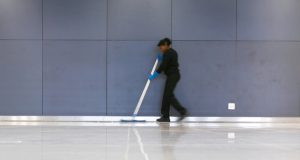Julie Godefroy, Technical Manager at CIBSE, advises on ways to improve indoor air quality in the absence of a definitive regulatory framework
People spend up to 90 per cent of their time indoors. It will come as no surprise, therefore, that there are increasing concerns about the quality of air and the health impacts of air pollution inside offices, schools and other building types. Air pollution indoors, which is often down to a mixture of pollutants from both inside and outside the building, can be significantly worse than outdoors.
Pollutants from indoor sources include particulate matter and nitrogen oxide from combustion sources (such as gas cooking or indoor fires), chemicals released from building materials, finishes, furnishings, paints and cleaning products. Outside air pollution is generally the result of emissions from traffic as well as more site-specific sources such as industrial or agricultural activities. Pollutants can be introduced indoors through air infiltration, open windows or be drawn inside by the ‘fresh air’ intake of ventilation systems.
There is growing awareness of the importance of indoor air quality (IAQ) on occupant productivity and occupants’ health and wellbeing. Symptoms such as headaches, skin irritation, drowsiness and even respiratory problems have all been attributed to poor IAQ. In offices, IAQ issues can lead to complaints from occupants, lost productivity and even staff absences.
The latest issue of CIBSE’s Technical Memorandum TM40: Health and wellbeing issues in building services (due out later this month) points out that a number of studies have found benefits in improving IAQ by avoiding pollutant sources, providing adequate ventilation rates and filtering the air supply if needed.
The literature review carried out as part of the TM40 update has found some studies which reported improvement if fresh air rates were improved “beyond current best practice recommendations”, for example reducing non-specific symptoms such as headaches, irritation, self-reported lethargy and sick leave. The document says that two large, recent reviews have concluded that “in working (non-industrial) environments, the optimum fresh air rates would be between 20 and 30 litres/second/person”.
This figure is a significant increase compared to current recommendations of a minimum fresh air requirement of 8-10 l/s per person for a typical mechanically ventilated space. However, in TM40 CIBSE highlights that this is a developing area and that most studies “support the current guidelines on fresh air rates, avoiding mixing and recirculation, and recommended CO2 levels”.
In the large majority of cases, studies show that the main issue with indoor air quality starts with ventilation rates below good practice and below the design intent, often through inadequate design, installation, commissioning or maintenance. This points to the need for much better implementation of current guidelines, rather than a radical revisit of target ventilation rates.
There is currently no comprehensive and robustly implemented regulatory framework on indoor air quality in the UK – as is the case for most countries. In the current Building Regulations in both England and Wales, ventilation is currently used as a proxy for IAQ. Building Regulations Schedule 1, Part F, states that “there shall be adequate means of ventilation provided for people in the building”. Adequate is defined as a ventilation system “capable of limiting pollutants originating within a building which would otherwise be a hazard to the health of the people in the building”.
Appendix A of Approved Document F sets out current recommended levels of moisture and common pollutants, such as nitrogen dioxide and carbon monoxide. It also recommends that exposure to volatile organic compound (VOC) levels should not exceed 300µg/m3 averaged over eight hours. In addition, the draft revision to Document F also proposes maximum recommended levels of formaldehyde.
ADDRESSING IAQ ISSUES
There are concerns that under the current regulatory regime lack of verification and testing for air pollutants on completion of a building means that poor IAQ issues are going undetected prior to handover. The consultation draft goes some way towards addressing those concerns by emphasising the importance of commissioning and measuring actual ventilation rates at completion; it is also hoped that wider changes as part of the implementation of the Hackitt review will provide better and more consistent enforcement in the future.
The lack of a comprehensive framework for IAQ may change in the future, however, following recent amendments to the Energy Performance of Buildings Directive, which require national energy regulations to “optimise health, indoor air quality and comfort levels”. While not specifically setting levels of indoor air quality, the EPBD amendments make reference to 2009 World Health Organization (WHO) pollutant guidelines for the maximum concentrations of various volatile organic air pollutants, including benzene, naphthalene, nitrogen dioxide and formaldehyde.




